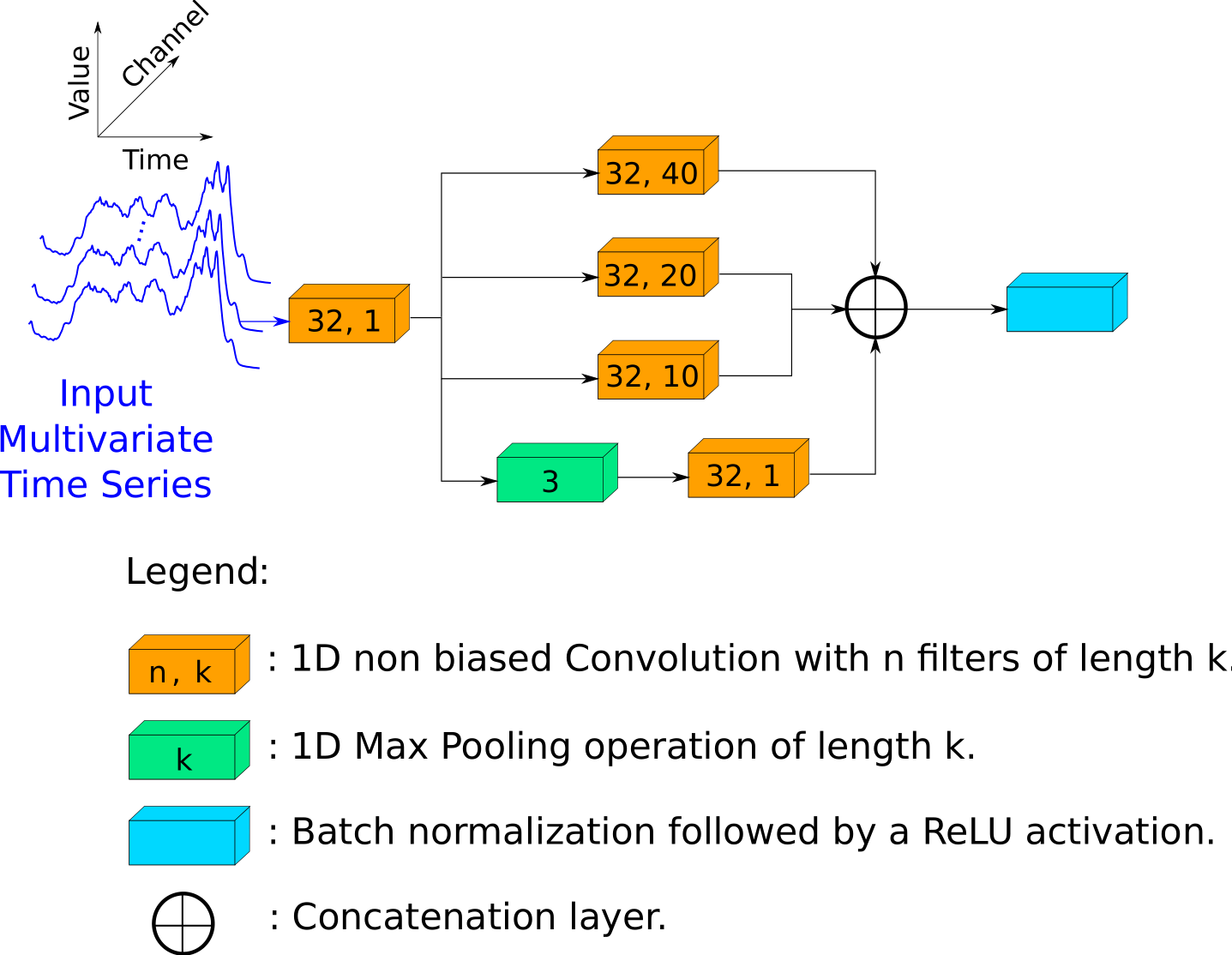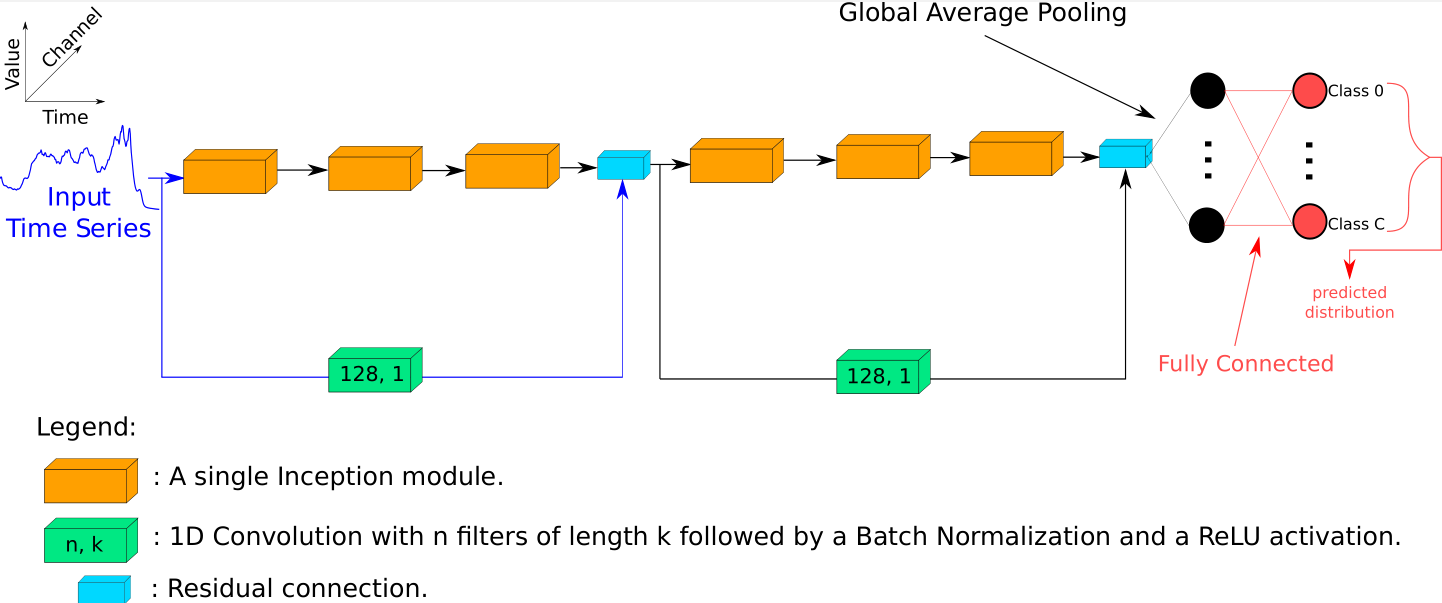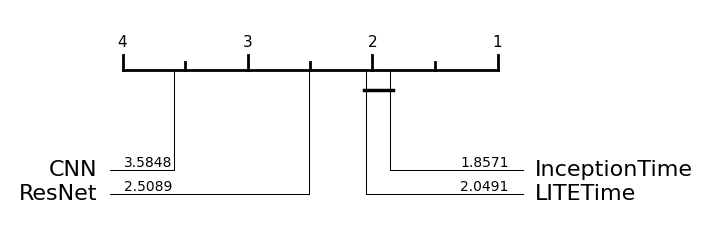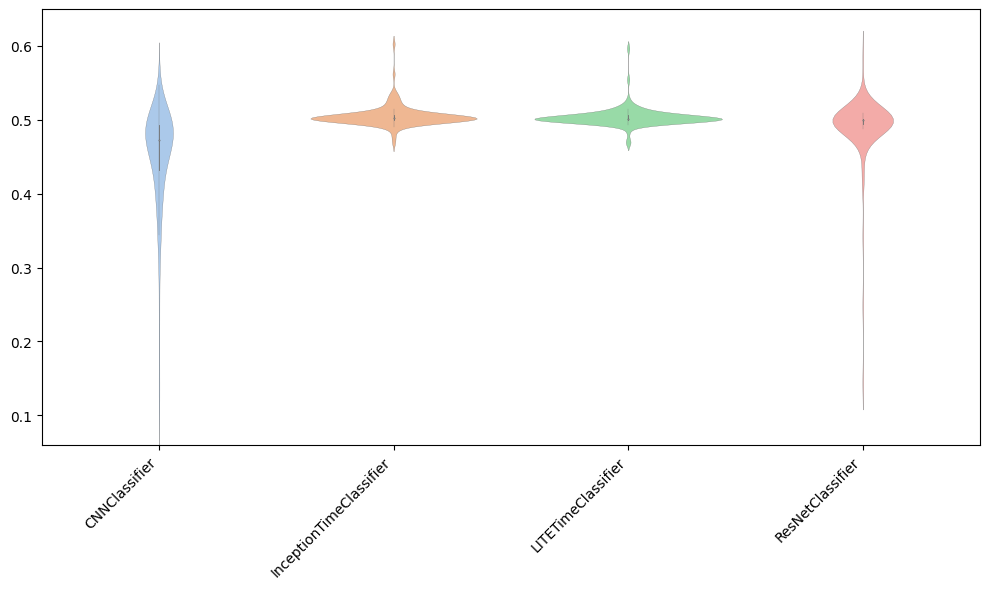Deep learning based time series classification in aeon#
There are a range of deep learning based classification algorithms in the toolkit. The networks that are common to classification, regression and clustering are in the networks module. Our deep learning classifiers are based those used in deep learning bake off [1] and recent experimentation [2]. [3] provides an extensive recent review of related deep learning work. review of related deep learning work.
A list of all deep learning classifiers
[5]:
import warnings
from aeon.registry import all_estimators
warnings.filterwarnings("ignore")
all_estimators("classifier", filter_tags={"algorithm_type": "deeplearning"})
[5]:
[('CNNClassifier', aeon.classification.deep_learning._cnn.CNNClassifier),
('EncoderClassifier',
aeon.classification.deep_learning._encoder.EncoderClassifier),
('FCNClassifier', aeon.classification.deep_learning._fcn.FCNClassifier),
('InceptionTimeClassifier',
aeon.classification.deep_learning._inception_time.InceptionTimeClassifier),
('IndividualInceptionClassifier',
aeon.classification.deep_learning._inception_time.IndividualInceptionClassifier),
('IndividualLITEClassifier',
aeon.classification.deep_learning._lite_time.IndividualLITEClassifier),
('LITETimeClassifier',
aeon.classification.deep_learning._lite_time.LITETimeClassifier),
('MLPClassifier', aeon.classification.deep_learning._mlp.MLPClassifier),
('ResNetClassifier',
aeon.classification.deep_learning._resnet.ResNetClassifier),
('TapNetClassifier',
aeon.classification.deep_learning._tapnet.TapNetClassifier)]
The use case for deep learning classifiers is identical to that of all classifiers. However, you need to have tensorflow installed in your environment. If you have a GPU correctly installed the classifiers should use them, although it is worth checking the output.
[6]:
from sklearn.metrics import accuracy_score
from aeon.classification.deep_learning import CNNClassifier
from aeon.datasets import load_basic_motions # multivariate dataset
from aeon.datasets import load_italy_power_demand # univariate dataset
italy, italy_labels = load_italy_power_demand(split="train")
italy_test, italy_test_labels = load_italy_power_demand(split="test")
motions, motions_labels = load_basic_motions(split="train")
motions_test, motions_test_labels = load_basic_motions(split="train")
cnn = CNNClassifier()
cnn.fit(italy, italy_labels)
y_pred = cnn.predict(italy_test)
accuracy_score(italy_test_labels, y_pred)
65/65 [==============================] - 0s 726us/step
[6]:
0.9533527696793003
Classifier Details#
The deep learning bake off [1] found that the Residual Network (ResNet) was the best performing architecture for TSC. ResNet has the following network structure.

The InceptionTime deep learning algorithm Subsequent to [1], InceptionTime is an ensemble of five SingleInceptionTime deep learning classifiers. Each base classifier shares the same architecture based on Inception modules. Diversity is achieved through randomly intialising weights. A SingleInceptionTimeClassifier has the following structure.

A SingleInceptionTimeClassifier is structured as follows.

Performance on the UCR univariate datasets#
You can find the dictionary based classifiers as follows. Please note we have not fully evaluated all the deep learners yet, they take a long time to run.
[1]:
from aeon.registry import all_estimators
est = all_estimators("classifier", filter_tags={"algorithm_type": "deeplearning"})
for c in est:
print(c)
('CNNClassifier', <class 'aeon.classification.deep_learning._cnn.CNNClassifier'>)
('EncoderClassifier', <class 'aeon.classification.deep_learning._encoder.EncoderClassifier'>)
('FCNClassifier', <class 'aeon.classification.deep_learning._fcn.FCNClassifier'>)
('InceptionTimeClassifier', <class 'aeon.classification.deep_learning._inception_time.InceptionTimeClassifier'>)
('IndividualInceptionClassifier', <class 'aeon.classification.deep_learning._inception_time.IndividualInceptionClassifier'>)
('IndividualLITEClassifier', <class 'aeon.classification.deep_learning._lite_time.IndividualLITEClassifier'>)
('LITETimeClassifier', <class 'aeon.classification.deep_learning._lite_time.LITETimeClassifier'>)
('MLPClassifier', <class 'aeon.classification.deep_learning._mlp.MLPClassifier'>)
('ResNetClassifier', <class 'aeon.classification.deep_learning._resnet.ResNetClassifier'>)
('TapNetClassifier', <class 'aeon.classification.deep_learning._tapnet.TapNetClassifier'>)
[2]:
from aeon.benchmarking import get_estimator_results_as_array
from aeon.datasets.tsc_datasets import univariate
names = [t[0].replace("Classifier", "") for t in est]
# Not done these yet
names.remove("Encoder")
names.remove("FCN")
names.remove("IndividualInception")
names.remove("IndividualLITE")
names.remove("MLP")
names.remove("TapNet") # Multivariate only
results, present_names = get_estimator_results_as_array(
names, univariate, include_missing=False
)
results.shape
[2]:
(112, 4)
[3]:
from aeon.visualisation import plot_boxplot_median, plot_critical_difference
plot_critical_difference(results, names)
[3]:
(<Figure size 600x230 with 1 Axes>, <Axes: >)

[6]:
plot_boxplot_median(results, names)
[6]:
(<Figure size 1000x600 with 1 Axes>, <Axes: >)

References#
[1] Fawaz et al. (2019) “Deep learning for time series classification: a review” Data Mining and Knowledge Discovery. 33(4): 917-963
[2] Fawaz et al. (2020) “InceptionTime: finding AlexNet for time series classification. Data Mining and Knowledge Discovery. 34(6): 1936-1962
[3] Foumani et al. (2023) “Deep Learning for Time Series Classification and Extrinsic Regression: A Current Survey” ArXiv https://arxiv.org/pdf/2302.02515.pdf
Generated using nbsphinx. The Jupyter notebook can be found here.